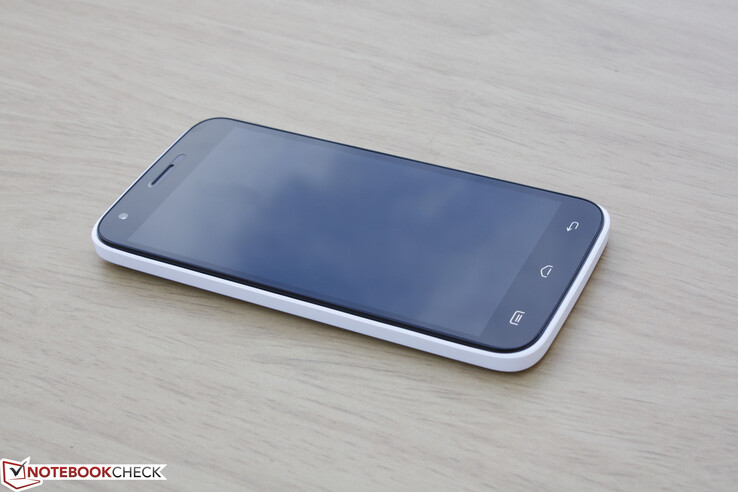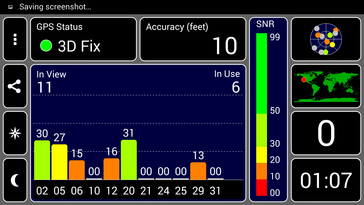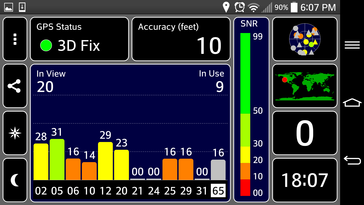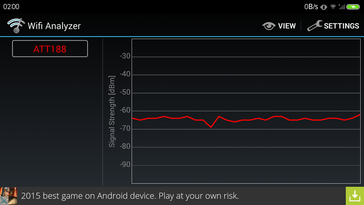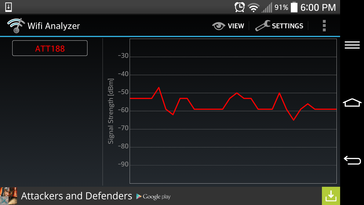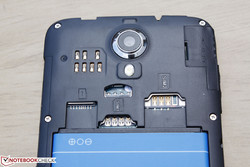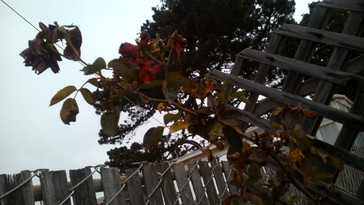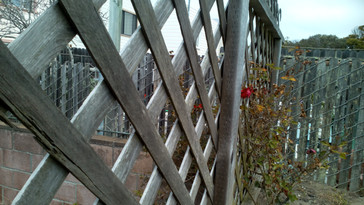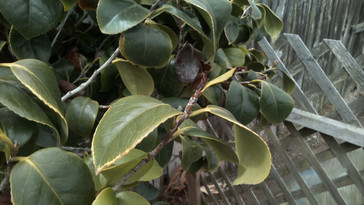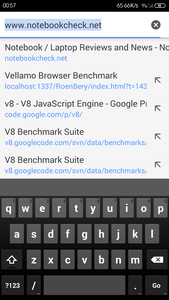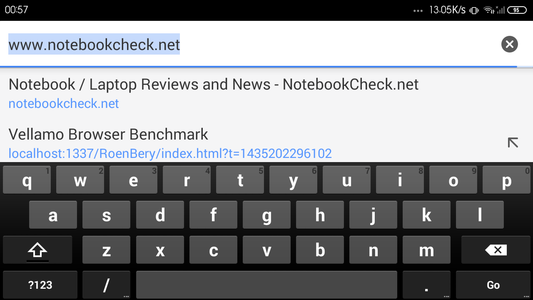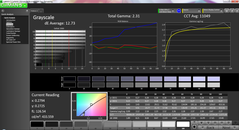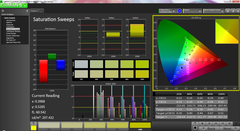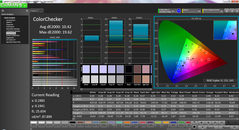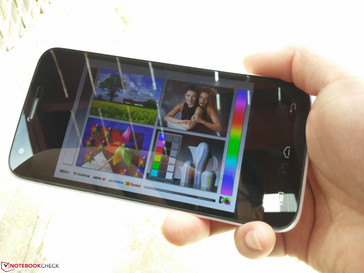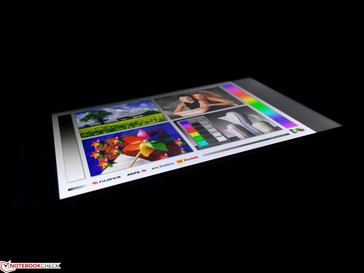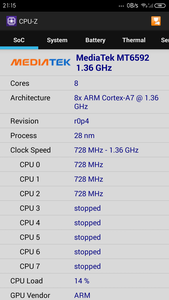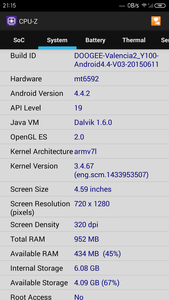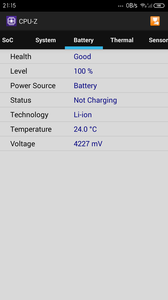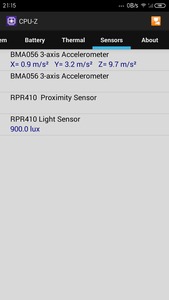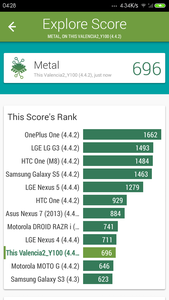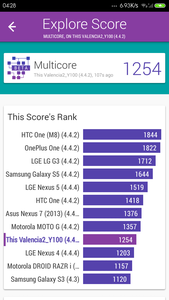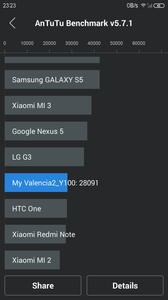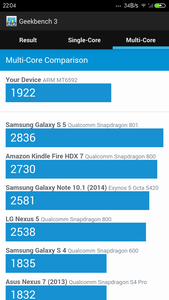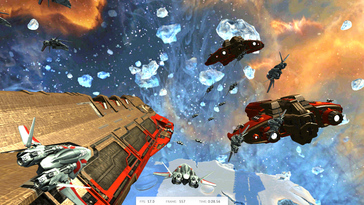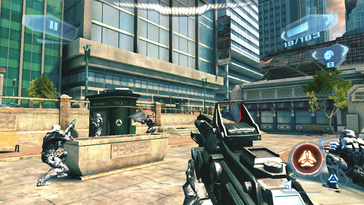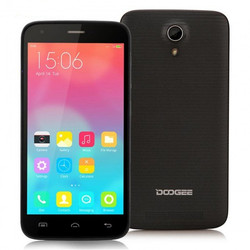Doogee Valencia2 Y100 Smartphone Review

The Valencia2 Y100 is Doogee's budget model as part of the Y100 family. A sleeker and stronger Y100 Pro model is also available with 4G support, a metal body, and slightly more powerful specifications, but both models make use of the same 5-inch 720p display.
Our Y100 today boasts an 8-core MediaTek processor with 1 GB RAM and an uncommonly used back touch panel for even more user control. The smartphone retails for about $100 USD, which only makes these features all the more lucrative. Everything sounds great on paper, but is performance really up to spec?
Case
Case quality is strong from bottom to top. The smartphone resists twists and depressions very well thanks to the relatively thick removable back cover. The corners and edges of the back cover are larger than on most other smartphones to better protect the phone from nicks and drops. This does, however, make the phone appear larger than it really is with a thicker bezel.
Quality is not perfect either despite the good first impression. While twisting won't easily damage the device, creaking can be heard between the phone and back cover. It appears that the plastic case does not fit perfectly onto the phone, so any gaps between them will rub against one another. Furthermore, the Volume rocker and Power button are on the soft side with weak feedback when pressed.
The back cover utilizes a "wheat texture design" that Doogee claims is comfortable and both anti-fingerprint and anti-sliding. We can certainly vouch for these claims as the matte cover is indeed free of fingerprints and easier to hold when compared to smooth plastic cases. Additional colors are available including Lime, Teal, Black, and Pink. Nonetheless, the case here doesn't hold a candle to metal alloy smartphones in terms of looks and feel. These types of plastic cases are almost always only found on budget and lower-end mainstream devices.
As for size, our comparison below shows that the Y100 is about average for a 5-inch phone. The Huawei Honor 3C has a smaller footprint while the Zenfone 5 is larger in general. However, the Doogee is indeed a hair thinner than most other inexpensive phones of similar size.
Connectivity
The basic Micro-USB 2.0 and 3.5 mm headset ports are included with no extras. USB OTG is supported for users who want to connect generic mice, keyboards, and USB flash drives. We also connected a MHL cable to test for compatibility, but to no avail.
Remove the back cover and additional slots become available. MicroSD, micro-SIM, and Mini-SIM cards can be inserted after removal of the battery.
Note that the thick back cover can make it difficult for some Micro-USB cables to make full physical contact with the USB port. This is common on many budget smartphones and can lead to loose connections if the Micro-USB end is too short. Thankfully, the included cable with our Doogee is long enough to avoid the issue.
Communication & GPS
The integrated GPS and WLAN radio both work without issues. The 802.11n radio in particular appears weaker than the radio in the LG G2 when at equal distance from the WLAN source. Nonetheless, the signal is more consistent and just as reliable.
Telephone & Speech Quality
Official compatibility includes 2G GSM (850/900/1800/1900MHz) and 3G WCDMA (850/1900/2100MHz). Thus, 4G is not an option for this particular model and is instead standard on the Y100 Pro.
The Y100 accepts Micro-SIM in slot #1 and Mini-SIM in slot #2. The phone can still make calls from the second SIM card even if the first slot is empty, which is not always the case on dual SIM smartphones. We are able to connect and makes calls on both AT&T and T-Mobile towers in the States. Sprint users are again out of luck in this case.
Call quality is very good with little static and no voice drops on full reception. We are able to listen clearly to the person on the other end holding a LG G2. Likewise, the receiver had no issues listening to the caller. However, sound is a bit on the softer side for our listener, so it may be more difficult if background noise is present. The Doogee does not support Wi-Fi calling unlike on the Sharp Aquos Crystal.
Cameras
The 13 MP and 5 MP rear and front cameras are advertised as Sony sensors to imply quality. Unfortunately, picture quality is well below average. Color temperature is overly cool and the rear camera is unable to clearly focus. The pictures below were taken on a sunny day, but performance is even worse under low-light conditions with its very weak LED flash.
Video recording supports up to 1080p24. Quality is poor with heavy blurring. The phone also supports ClearMotion technology to give 30 FPS videos the appearance of 60 FPS, including YouTube content. This is achieved by artificially doubling the frame rate and then repeating the frames for smoother playback. It certainly works as advertised, but videos with fast motion become even blurrier.
Accessories & Warranty
Doogee throws in a back cover, screen protector, screen wipe, Micro-USB cable, AC adapter, and earphones with every new purchase. The standard 12-month warranty applies to the smartphone only and not to any of the accessories.
Input Devices
Touchscreen
The 5-point capacitive touchscreen works without issues, which is not something we can say for all budget smartphones. The screen is equally responsive around the edges and corners as it is towards the center. Typing with the onscreen keyboard is effortless and the device registers inputs accurately. Letters appear onscreen as quickly as the user can type them.
Unusually, the virtual keyboard responds more slowly when on the Landscape orientation. The phone is more likely to misinterpret inputs and output experiences slightly more lag.
Back Touch Panel
Touch panels on the back of smartphones are not entirely new, but at the same time they are not a common find on models retailing for $100 USD. The touch sensors can be seen on the inside surface of the back cover. They are quite small at just under 5 x 5 cm, so the user has only a tiny surface to work with.
There are reasons why back touch panels are not more prevalent. For one, performance is not consistent because of the small surface area. Precision inputs are difficult and the panel is largely useless for actions other than page scrolling. Secondly, it is generally uncomfortable to use compared to simply using your thumb or other hand. Lastly, accidental inputs will happen frequently. The panel can be customized to quickly unlock the phone or launch the camera, but this can only lead to instances where the camera unexpectedly launches whilst the user is browsing, playing games, or performing other actions. Thankfully, the back panel feature can be easily disabled in the Settings menu.
Display
Pictures and texts appear very sharp on the Valencia2 Y100 even for a budget 720p smartphone. The screen itself is very close to the surface as the device utilizes OGS (One Glass Solution) technology, which is a similar technique used on newer Apple iPhones. Contrast and brightness are both above average for the price category as well. In fact, they rival more mainstream devices like the recent Asus ZenFone 5.
| |||||||||||||||||||||||||
Brightness Distribution: 95 %
Center on Battery: 434.2 cd/m²
Contrast: 747:1 (Black: 0.581 cd/m²)
ΔE Color 10.42 | 0.5-29.43 Ø5
ΔE Greyscale 12.73 | 0.57-98 Ø5.3
Gamma: 2.31
| Doogee Valencia2 Y100 | Asus Zenfone 5 | Samsung Galaxy Grand Prime | Microsoft Lumia 640 | Honor 3C | Sharp Aquos Crystal | |
|---|---|---|---|---|---|---|
| Screen | 14% | 2% | 24% | 17% | 11% | |
| Brightness middle | 434.2 | 389 -10% | 426 -2% | 433 0% | 474 9% | 401.6 -8% |
| Brightness | 428 | 375 -12% | 415 -3% | 429 0% | 449 5% | 410 -4% |
| Brightness Distribution | 95 | 88 -7% | 90 -5% | 95 0% | 90 -5% | 93 -2% |
| Black Level * | 0.581 | 0.58 -0% | 0.83 -43% | 0.52 10% | 0.7 -20% | 0.72 -24% |
| Contrast | 747 | 671 -10% | 513 -31% | 833 12% | 677 -9% | 558 -25% |
| Colorchecker dE 2000 * | 10.42 | 4.22 60% | 5.98 43% | 3.42 67% | 3.59 66% | 3.63 65% |
| Greyscale dE 2000 * | 12.73 | 3.08 76% | 6.03 53% | 3.03 76% | 3.46 73% | 2.84 78% |
| Gamma | 2.31 95% | 2.57 86% | 2.48 89% | 2.16 102% | 2.58 85% | 2.16 102% |
| CCT | 11049 59% | 6840 95% | 7983 81% | 7081 92% | 7437 87% | 6658 98% |
* ... smaller is better
Color reproduction is where the Doogee begins to fall apart. Color temperature is overly cool for a poor grayscale and Teal in particular is very inaccurate. Hues are well represented at high saturation levels, but they only become more inaccurate at lower saturation. It's a bit of a shame as both Red and Green are otherwise quite balanced. Competing smartphones like the ZenFone 5 and Galaxy Grand Prime have more accurate colors than the Doogee in comparison.
With an average screen brightness of over 400 nits, the Valencia2 Y100 works generally well outdoors. The screen is still not bright enough to overcome direct sunlight and most glare, so shade or an overcast day are still better conditions.
Viewing angles are excellent as expected from an IPS panel. This helps tremendously in avoiding inevitable glare.
Performance
The 1.7 GHz MediaTek MT6592 SoC is a mid-range octa-core SoC. A higher number of cores does not equate to better CPU performance the same way that a higher megapixel count does not equate to better camera performance.
Here on the Doogee Y100, the processor has been underclocked from 1.7 GHz to 1.36 GHz. All eight cores are able to run at 1.36 GHz simultaneously. Otherwise, all but one core will be disabled and running at 728 MHz when the system is idling. The lower maximum frequency on the MediaTek puts single-core performance in the same ballpark as entry-level Snapdragon SoCs, while multi-core performance still rivals the Snapdragon 600 series. More technical data and benchmarks on the MT6592 can be found on our dedicated CPU page here.
System RAM is just 1 GB, which we see as the bare minimum for new Android smartphones. Free RAM is just above half according to CPU-Z when no other applications are running.
System Performance
Subjectively, the Y100 is generally a smooth experience. The phone begins to falter when launching and exiting applications as there is a clear delay before the action appears onscreen. For example, pressing the Home button can result in icons still loading as they gradually pop into place. This problem only intensifies when multiple applications are running as system RAM is limited. More powerful mainstream or flagship models are the easiest solution if users demand strong multi-tasking performance out of a smartphone.
According to Android benchmarks like Vellamo and 3DMark, the MT6592 SoC shows similar multi-core performance scores as the Snapdragon 400 and 615 in the Zenfone 5 and ZTE Blade S6, respectively. Graphics power, however, falls well below the Adreno 430 and PowerVR G6430 in the One M9 and Zenfone 2, respectively.
| PCMark for Android - Work performance score (sort by value) | |
| Doogee Valencia2 Y100 | |
| ZTE Blade S6 | |
| Asus Zenfone 2 ZE551ML | |
| HTC One M9 | |
| Sunspider | |
| 1.0 Total Score (sort by value) | |
| Doogee Valencia2 Y100 | |
| Honor 3C | |
| Asus Zenfone 5 | |
| ZTE Blade S6 | |
| Asus Zenfone 2 ZE551ML | |
| HTC One M9 | |
| 0.9.1 Total Score (sort by value) | |
| Doogee Valencia2 Y100 | |
| Asus Zenfone 2 ZE551ML | |
| HTC One M9 | |
| Google V8 Ver. 7 - Google V8 Ver. 7 Score (sort by value) | |
| Doogee Valencia2 Y100 | |
| Asus Zenfone 5 | |
| ZTE Blade S6 | |
| Asus Zenfone 2 ZE551ML | |
| HTC One M9 | |
| Octane V2 - Total Score (sort by value) | |
| Doogee Valencia2 Y100 | |
| Honor 3C | |
| Asus Zenfone 5 | |
| ZTE Blade S6 | |
| Asus Zenfone 2 ZE551ML | |
| HTC One M9 | |
| Mozilla Kraken 1.1 - Total (sort by value) | |
| Doogee Valencia2 Y100 | |
| Honor 3C | |
| Asus Zenfone 5 | |
| ZTE Blade S6 | |
| Asus Zenfone 2 ZE551ML | |
| HTC One M9 | |
| WebXPRT 2015 - Overall (sort by value) | |
| Doogee Valencia2 Y100 | |
| Asus Zenfone 2 ZE551ML | |
| HTC One M9 | |
| Peacekeeper - --- (sort by value) | |
| Doogee Valencia2 Y100 | |
| Asus Zenfone 2 ZE551ML | |
| HTC One M9 | |
| AndEBench | |
| Java (sort by value) | |
| Doogee Valencia2 Y100 | |
| Asus Zenfone 2 ZE551ML | |
| HTC One M9 | |
| Native (sort by value) | |
| Doogee Valencia2 Y100 | |
| Asus Zenfone 2 ZE551ML | |
| HTC One M9 | |
| Epic Citadel | |
| Ultra High Quality (sort by value) | |
| Asus Zenfone 2 ZE551ML | |
| HTC One M9 | |
| High Quality (sort by value) | |
| Doogee Valencia2 Y100 | |
| Asus Zenfone 2 ZE551ML | |
| High Performance (sort by value) | |
| Doogee Valencia2 Y100 | |
| Asus Zenfone 2 ZE551ML | |
| Geekbench 3 | |
| 32 Bit Multi-Core Score (sort by value) | |
| Honor 3C | |
| Asus Zenfone 5 | |
| HTC One M9 | |
| 32 Bit Single-Core Score (sort by value) | |
| Honor 3C | |
| Asus Zenfone 5 | |
| HTC One M9 | |
| 64 Bit Multi-Core Score (sort by value) | |
| Doogee Valencia2 Y100 | |
| ZTE Blade S6 | |
| Asus Zenfone 2 ZE551ML | |
| HTC One M9 | |
| 64 Bit Single-Core Score (sort by value) | |
| Doogee Valencia2 Y100 | |
| ZTE Blade S6 | |
| Asus Zenfone 2 ZE551ML | |
| HTC One M9 | |
* ... smaller is better
Gaming Performance
The integrated ARM Mali-450 GPU is common on inexpensive smartphones and even tablets like the Acer Iconia Tab 10 and Huawei MediaPad M1 8.0. It works very well when paired with a 720p display. Titles like N.O.V.A. 3 are playable at what appears to be 20 - 30 FPS, but more demanding games like Anomaly 2 will see frame rate issues. Of course, 2D titles like Angry Birds play problem-free.
Synthetic graphics benchmarks place the Doogee alongside the SGX544 MP2 and Adreno 305. The Adreno 320 is at least 50 percent faster according to 3DMark Ice Storm at 1080p, whereas the Y100 can barely run 3DMark at a consistent 20 - 30 FPS at the same resolution.
Emissions
Temperature
Surface temperature is flat across the board when idling as is normal for most smartphones. The Doogee does heat up quite a bit when under unrealistically high loads up to a measured surface temperature of just over 38 C. It never becomes uncomfortable to hold regardless of the onscreen activity as this hot spot is concentrated on the top portion of the device. Users may notice the warmth when using the phone in Landscape orientation.
It's worth noting that the 5-inch Archos 50c uses the same MediaTek SoC as our Doogee, yet it experiences higher surface temperatures under similar testing conditions.
(+) The maximum temperature on the upper side is 37.4 °C / 99 F, compared to the average of 35 °C / 95 F, ranging from 21.9 to 56 °C for the class Smartphone.
(+) The bottom heats up to a maximum of 38.2 °C / 101 F, compared to the average of 33.8 °C / 93 F
(+) In idle usage, the average temperature for the upper side is 26.3 °C / 79 F, compared to the device average of 32.7 °C / 91 F.
Speakers
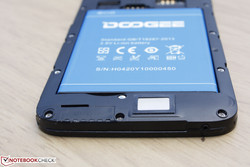
The single rear speakerphone is loud, clear, and mostly static-free for media playback. Bass is severely lacking as is expected from a small and inexpensive smartphone. There is a Bass Enhancement option in the Settings menu, though it does little to boost quality and instead appears to just increase volume. Earphones are still the best option for a better audio experience.
Battery Life
Runtimes from the removable 3.8 V battery are below average. All competing models in our comparison table below feature longer battery lives under our standard testing conditions. Users can expect just over 2.5 hours of runtime at the very worst and almost 6 hours of constant WLAN use with the Doogee at 150 nit brightness (~30 percent setting). Purchasing a second backup battery or even an external power bank is recommended for long trips.
| Doogee Valencia2 Y100 8.4 Wh | Asus Zenfone 5 2110 mAh | Samsung Galaxy Grand Prime 9.9 Wh | Microsoft Lumia 640 9.5 Wh | Honor 3C 8.8 Wh | Sharp Aquos Crystal 2040 mAh | |
|---|---|---|---|---|---|---|
| Battery Runtime | 62% | 52% | 39% | 25% | 69% | |
| Reader / Idle | 619 | 1131 83% | 986 59% | 1078 74% | 1413 128% | |
| WiFi v1.3 | 353 | 512 45% | 502 42% | |||
| Load | 164 | 229 40% | 166 1% | 205 25% | 178 9% | |
| WiFi | 545 | 587 | 514 |
Pros
Cons
Verdict
Back touch panel. Sony camera sensors. Octa-core processor. These are features you would expect to hear on a flagship smartphone worth hundreds of dollars. Instead, these could all be yours for just about $100 USD on the Doogee Valencia2 Y100.
This sounds great in printing, but scratch beneath the surface and you will find poor cameras, mediocre performance, and an unreliable back touch panel. It's a good budget phone as long as expectations are kept in check.
We do praise the OGS display for its bright backlight and deep contrast. It certainly had us surprised to see such a nice screen on an inexpensive device. The drawbacks are inaccurate colors and grayscale with below average battery life. We would have liked to see Wi-Fi calling as well. Regardless, it's hard to argue against a smartphone that is just a fraction of the price compared to current mainstream offerings.
The Doogee Valencia2 Y100 can be purchased here at Gearbest for $95.
We do praise the OGS display for its bright backlight and deep contrast. It certainly had us surprised to see such a nice screen on an inexpensive device.
Doogee Valencia2 Y100
-
06/30/2015 v4(old)
Allen Ngo


 Deutsch
Deutsch English
English Español
Español Français
Français Italiano
Italiano Nederlands
Nederlands Polski
Polski Português
Português Русский
Русский Türkçe
Türkçe Svenska
Svenska Chinese
Chinese Magyar
Magyar